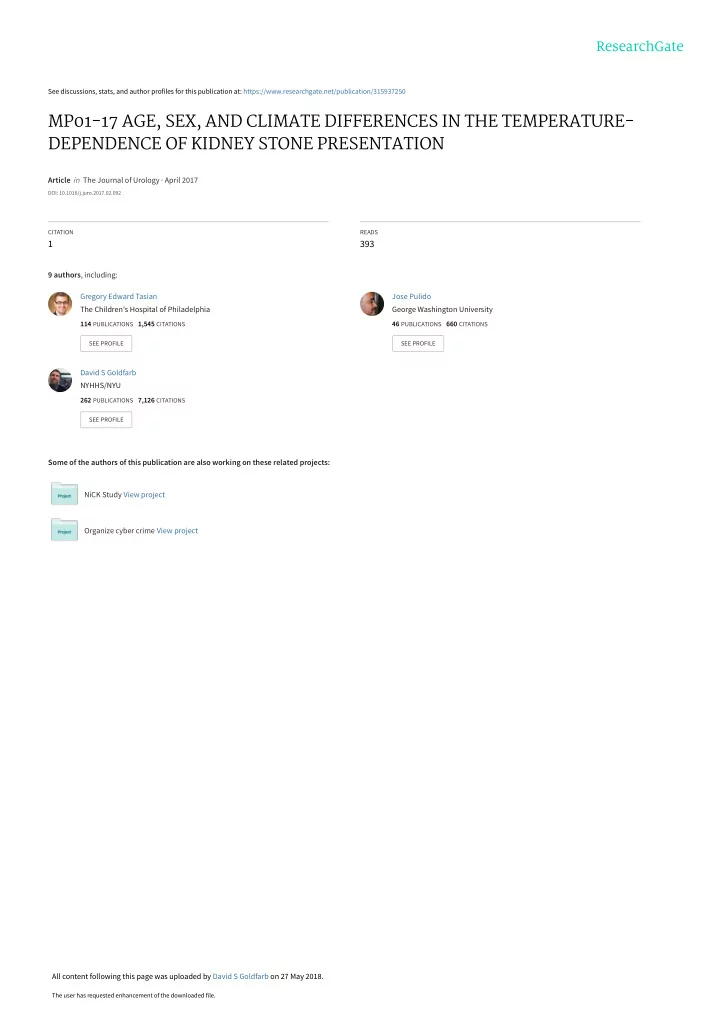

See discussions, stats, and author profiles for this publication at: https://www.researchgate.net/publication/315937250 MP01-17 AGE, SEX, AND CLIMATE DIFFERENCES IN THE TEMPERATURE- DEPENDENCE OF KIDNEY STONE PRESENTATION Article in The Journal of Urology · April 2017 DOI: 10.1016/j.juro.2017.02.092 CITATION READS 1 393 9 authors , including: Gregory Edward Tasian Jose Pulido The Children's Hospital of Philadelphia George Washington University 114 PUBLICATIONS 1,545 CITATIONS 46 PUBLICATIONS 660 CITATIONS SEE PROFILE SEE PROFILE David S Goldfarb NYHHS/NYU 262 PUBLICATIONS 7,126 CITATIONS SEE PROFILE Some of the authors of this publication are also working on these related projects: NiCK Study View project Organize cyber crime View project All content following this page was uploaded by David S Goldfarb on 27 May 2018. The user has requested enhancement of the downloaded file.
THE JOURNAL OF UROLOGY � Vol. 197, No. 4S, Supplement, Friday, May 12, 2017 e7 comprehensive teaching strategies for patients regarding the modi fi able RESULTS: A total of 4,440 patients included in the fi nal ana- risk factors for nephrolithiasis. lyses were classi fi ed into four groups: calcium oxalate (CaOx) (n ¼ 3213), CaOx + calcium phosphate (CaP) (n ¼ 881), CaP (n ¼ 115), uric acid (UA) (n ¼ 191). The proportions of patients with recurrent and/or multiple stones signi fi cantly increased with the number of MetS traits only in patients with CaOx stone (P < 0.01, table 1). However, similar associations were not observed in patients with other stone composi- tions. In patients with CaOx stone, there was a signi fi cant and stepwise increase in the odds of recurrent and/or multiple stones after adjustment for age and sex. In patients with 3 or 4 MetS traits, the odds was 1.8-fold greater compared with patients with 0 traits (OR, 1.78; 95% CI, 1.29- 2.42). In addition, the presence of MetS traits was associated with signi fi cantly increased odds of having hypercalciuria in patients with CaOx stone after adjustment for age and sex. CONCLUSIONS: In patients with CaOx stone, MetS trait clus- tering is associated with greater severity of the disease and increased urinary calcium excretion. These results suggest that CaOx stone dis- ease should be regarded as a systemic disorder linked to MetS. Source of Funding: none MP01-17 AGE, SEX, AND CLIMATE DIFFERENCES IN THE TEMPERATURE-DEPENDENCE OF KIDNEY STONE PRESENTATION Gregory Tasian*, Philadelphia, PA; Ana Vicedo-Cabrera, Basel, Switzerland; Robert Kopp, New Brunswick, NJ; Lihai Song, Michelle Ross, Jose Pulido, Steven Warner, Philadelphia, PA; David Goldfarb, New York, NY; Susan Furth, Philadelphia, PA Source of Funding: none INTRODUCTION AND OBJECTIVES: Prior studies have demonstrated that high daily temperatures increase the risk of kidney stone presentation, men produce more sweat than women, and people MP01-16 with public insurance have greater exposure to ambient temperatures METABOLIC SYNDROME INCREASES THE RISK FOR than those with private insurance. The objective of this study was to CALCIUM OXALATE STONE FORMATION: RESULTS FROM determine differences in the temperature dependence of kidney stone A NATIONWIDE SURVEY ON UROLITHIASIS IN JAPAN presentation by sex, age, race, climate, and insurance type. METHODS: We performed a time series study of 132,597 pa- Akinori Iba*, Yasuo Kohjimoto, Takashi Iguchi, Shimpei Yamashita, tients who presented with kidney stones to Emergency Departments in Satoshi Nishizawa, Kazuro Kikkawa, Isao Hara, Wakayama, Japan South Carolina from 1996-2015. Conditional Poisson regression and INTRODUCTION AND OBJECTIVES: Recent epidemiologic distributed lag non-linear models were used to assess the association studies have shown an increased prevalence of kidney stones in pa- and lagged response between daily temperature and kidney stone tients with metabolic syndrome (MetS). We have reported that the presentation strati fi ed by sex, age, insurance type, race, and clustering of MetS traits is associated with greater severity of kidney climate zone. stone disease (Am J Kidney Dis 61: 923-929, 2013). The aim of the RESULTS: The relative risk for a daily temperature at the 99th present study is to clarify which stone composition is associated percentile versus 10 � C was 1.72 (95% CI 1.55, 1.91) for men and 1.15 with MetS. (95% CI 1.01, 1.31) for women. This difference was greatest among METHODS: We retrospectively analyzed detailed clinical data patients 20-65 years old. The risk of kidney stone presentation following from 30,448 patients with urolithiasis enrolled in the 6th Nationwide moderately high daily temperatures was less among patients living in Survey on Urolithiasis in Japan conducted in 2005. Patients with lower warmer climates. The temperature-dependence of stone presentation urinary tract stones, struvite stones, cystine stones, other types of rare did not differ by race or insurance type. stone composition, unknown stone composition, or hyperparathyroidism CONCLUSIONS: The risk of kidney stone presentation and those younger than 15 years were excluded. According to the types following high daily temperatures was substantially greater among men of stone composition, the severity of kidney stone disease, assessed by than women and similar between patients with public and private in- the number of existing stones (single/multiple) and number of stone surance, which suggests that the higher risk among men is due to the episodes ( fi rst time/recurrent), and abnormalities in urine constituents sexually dimorphic effect of heat on evaporative water loss rather than were examined by the number of MetS traits (obesity, hypertension, greater exposure to ambient temperature. The lower risk among pa- dyslipidemia, and diabetes). tients living in warmer climates suggests that prolonged heat exposure
Recommend
More recommend